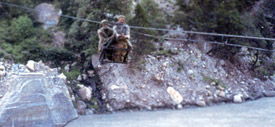|
Rivers

Himachal provides water to both the Indus and Ganges
basins. The major river systems of the region are the Chandrabhaga or
the Chenab, the Ravi, the Beas, the Sutlej and the Yamuna. These perennial
rivers are fed by snow and rainfall and are protected by a fairly extensive
cover of natural vegetation.
The Beas (Vedic name Arjikiya and in later Sanskrit Vipasa)
rises in the Pir Panjal range near the Rohtang
Pass and flows some 256km in Himachal. The river is formed by a number
of tributaries, the important being the Parbati, the Hurla, the Sainj,
the Uhl, the Suheti, the Luni, the Banganga and the Chaki. The northern
and eastern tributaries of the Beas are snow fed and perennial, while
the southern affluent are seasonal. During August, increase in inflow
sometimes results in floods.
The Chandrabhaga or Chenab (Vedic name Askni), the largest
river (in volume of water) is formed after the meeting of 2 streams,
Chandra and Bhaga at Tundi, in Lahul. It flows 122kms and has a catchments
area of 7500sq.km. in Himachal, before entering Kashmir. The Chandra passes
through barren land where there are no signs of life.
 The Ravi (Vedic name Purushni and in later Sanskrit Iravati)
is born in Bara Banghal, Kangra district as a joint stream formed by the
glacier fed Bhadal and Tantgari. The river has a length of about 158km
and has a catchment area of about 5451km. Chamba lies on its right Bank.
The Sutlej
(Vedic name Saturdi and in later Sanskrit Shatadru) originates in distant
Tibet. It cuts through both the great Himalayan and the Zaskar ranges
and crosses the Indo-Tibetan border near Shipkila. Then the river Spiti
joins it from the north. Passing through precipitous gorges and narrow
valleys it emerges from the mountains at Bhakra. The catchment area of
Sutlej in Himachal is 20,000sq.km.
The Yamuna has its origin in Yamunotri in Uttar Kashi
(Uttar Pradesh). Its total catchment area in Himachal is 2320sq.km. Its
main tributaries are the Tons, the Giri and the Bata. |

